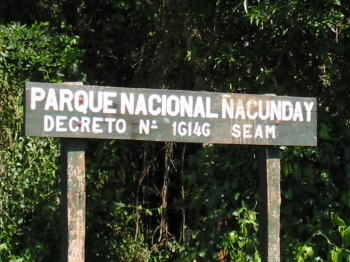By Claudia Pompa for LAB
 The land issue is at the core of many social problems in Paraguay, with the government of President Lugo facing intense criticism over its poor handling of the land conflict in Ñacunday, located in the south-eastern region of Alto Paraná. The conflict involves the 162,000 hectare of Tranquilino Favero, the largest soybean producer in the country.
The land issue is at the core of many social problems in Paraguay, with the government of President Lugo facing intense criticism over its poor handling of the land conflict in Ñacunday, located in the south-eastern region of Alto Paraná. The conflict involves the 162,000 hectare of Tranquilino Favero, the largest soybean producer in the country.
Mr Favero is one of the many Brazilians in Paraguay who are involved in the agricultural business, also known as brasiguayos. In November of last year, the Liga Nacional de Carperos, an association of landless farmers, invaded the property, claiming that Favero had obtained the titles illegally and that the land should be distributed among landless Paraguayan families.
After several months of increasing tensions and failed negotiations, the government finally promised the carperos 30,000 hectares and relocated them to a property within the Ñacunday National Park.
The relocation of the carperos has led to sharp criticism from the country’s main environmental organizations. The 2,000 hectares Ñacunday National Park protects one of the last remnants of Atlantic Forest within the Paraná River basin. The establishment of a carperos community in Ñacunday will undoubtedly lead to a loss of at least some of the park’s forest and wildlife, as well as the indigenous communities that depend on it.
The decision not only goes against national legislation and international conventions, but also sets a worrying precedent for other protected areas in the country. In public remarks, Miguel Angel Lopez Perito, chief of staff, claimed he knew the government was breaking the law. At the same time, the Minister of the Interior said the carperos were only being relocated to “logged areas”.
Yan Speranza, executive director of Fundación Moises Bertoni, an environmental NGO in Paraguay, explains: “the government cannot try to solve the land issue, which is a real and extremely complex problem, by creating another one. Relocating the carperos to a national reserve, which is public property and which belongs to all Paraguayans, is not going to solve the problem. It just increases it and creates new problems. The government has recognized that following the proper legal procedures is not going to produce any results soon and this case reveals the lack of institutions and weak rule of law in the country. Without proper enforcement mechanisms, the government is unable to solve a long-term problem that has increasingly polarized the population”
A weak state and rampant corruption are key issues in Paraguay. The Instituto de Desarrollo Rural y de la Tierra, (INDERT) (the state land reform agency), has been heavily criticized about its failure to investigate the close to 8 million hectares that were distributed to military and civilian supporters during the former dictatorship. It is believed that approximately 60% of those hectares were illegally acquired and later resold to brasiguayos with the support of INDERT. Furthermore, preliminary investigations by INDERT show that there are more land titles than actual land. In February, in a move that many see as an effort from President Lugo to show he was taking some action, the government decided to intervene, but little can be achieved until a comprehensive survey is carried out to determine land rights.
There is no easy way to solve the land issue in Paraguay, and the government will need to try and find a political solution to a long-standing problem that affects close to 400,000 families in the country. With elections approaching next year and politicians busy campaigning, the situation seems to be on hold, for the moment at least.

